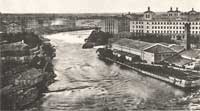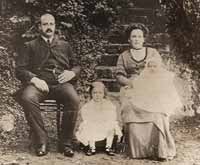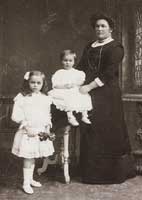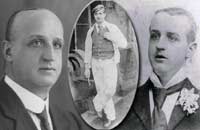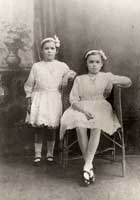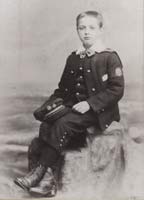
AN OLDHAM FAMILY GOES TO RUSSIA The story below comes from Alice Handley, who is the gt.grandaughter of Joseph & Hannah Cottam, and grandaughter of their son, Joseph, who married Alice Raine in 1904.
Some background to the story ... In 1842 Joseph Cottam was born in Oldham. He was the son of William (a Cotton Carder) and Ellen Cottam. On the 2nd of April, 1866, Joseph Cottam married Hannah Dawson at Prestwich Parish Church, St. Mary's. The register records that ... Joseph and Hannah would have a number of children, three of whom, George, James and Joseph (b. 1889) would all travel to Russia, with their respective families, to work in the cotton industry. If we go back to the 1851 census we find William & Ellen with their young family living on Moorhey Road, Oldham. ~~~~~~~~~~~~~~~~~~~~~~~~~~~~~~~~~~~~~~~~~ Alice's story ... "My Great Grandfather worked for the Moorfield Spinning Company, which was built in Oldham around 1875. Joseph was Cotton Carder, later becoming Mill Manager and continued working until he was presented with this Brooch in 1902, which says Presented to Mr J Cottam by The Card and Blowing Room Hands of Moorfield Spinning Co 1902. Oldham Pattern Mills were built all over the world and many Oldham managers went out to set up new mills particularly in Russia. Joseph met and married Hannah Dawson on 2nd April 1866 in The Parish of Prestwich. They had 6 children; their names were Sarah Ellen, George, John, James, Mary and the youngest Joseph - who became my Grand Father. They all followed their Father's footsteps working in the cotton mills, their jobs were; Sarah Ellen became a Cotton Rover; this meant she turned the raw cotton into a slender rope of parallel fibres. Joseph Cottam who was the youngest child of the six children, was born to Joseph and Hannah. Joseph met and married Alice Raine. Alice Raine was born 5th June 1879 at Chapel House Lunedale - Mickleton in Teesdale. Alice had 7 brother and sisters. Their names were; Thomas Edward, Ralph William, Sarah Jane (known as Sally), Elizabeth, Mary, Dorothy Annie, Charles. With such a large family, Alice moved to Clitheroe to live with her eldest brother Thomas, who was now a butcher. She worked as a maid in service when she met and married Joseph Cottam on 1st June 1904 at Crompton Church, Shaw in Oldham. They lived in Clitheroe where their first daughter may Hilda was born on 6th October 1905. Joseph's brother, George Cottam was asked by The Krahnholm Manufacturing Company from Estonia Russia, which was owned by two Barons, a rich family by the name of Andrew and Theodore Knoop. The company they owned consisted of a group of 5 cotton mills which was run by several members of their family and friends. George, accompanied by his wife Elizabeth, left for Russia to view the situation with the possibility of getting English mill managers to advise and show the Russians how to work the 5 factories. After deciding everything was fine, George then sent for his brother James, who left with his wife Mary. James became Mill Manager then a Director and also a Buyer. During the course of his work he travelled to China and Egypt, very often taking his wife with him. George then sent for his youngest brother Joseph who was now a Master Cotton Carder. Joseph left England in 1909 and emigrated to Russia taking with him his wife Alice and their only daughter at the time Hilda. During this time quite a large contingent of English and Scottish technicians emigrated and went to live in Narva, where they were all provided with furnished houses.
The Cottams and their families and technicians travelled overland when they emigrated crossing the North Sea from Newcastle to the Netherlands. From there was by Vogon-Lee to Berlin then onto Kizanholm and finally ending their journey at Narva. THE COTTAMS George made sure everything was up to the highest standard and if any of the English families were homesick, George made it possible for them to travel back home to England to reassure their families everything was fine, If he hadn't done this and taken on all the responsibility and made sure everything was up to the highest standard, he would never allowed or sent for anymore English families in the first place and for all he did for the English, Russian Government was awarded The Stanislav Order of Zeal - a very high honour for any foreigner to receive. He also became the British Vice Consul in Russia. NARVA 1900 - 1917 LIFE IN NARVA The houses were heated by wood fed stoves built of tiles to radiate the heat back into the room. As there were no open fires which some of the English found there was something missing. The kitchens were very large where the main heating came from Cooking was done by very large ovens, with deep backs. The wood was always stacked at one side of the kitchen. The outer doors and windows were double as in the winter it was the habit to place cotton wool between the two windows to prevent even the slightest of draughts. Winter transport for months on end was horse drawn sleigh. Clothing was suited to the weather padded coats and cloaks with large fur collars, fur hats and ear caps. thumbnail links
UNREST IN RUSSIA Unrest in Russia had been simmering for a long time then the Revolution broke out and the British embassy could no longer give protection to the English families. It was decided that the women and children should leave Russia. The English families were aware for a long time of the unrest and they were warned continually not to get into any arguments about the political situation because the British Embassy could not take responsibility for them. It was a great shock to all the English that they would have to leave. And from living a life of luxury very suddenly overnight they were all now refugees, fleeing the Country they had grown to love. Papers were hurriedly gathered together. Alice collected as much as she could get I.e. Treasures, silver etc. Reluctantly Alice and her two daughters, including all the other women said their farewells to their husbands (who had to stay behind and continue to manage the Cotton Mills.) The first stage of their journey was easy compared to the second and third stage. Alice and her daughters boarded a train, (along with all the other women) and taken 86 miles to St Petersburg. Hilda was now 12 years old and Hannah was 8. After they arrived in St Petersburg, they were told to get on a train which would take them to the fishing port of Archangel. The train was packed with refugees. Whole families lived in small compartments. There was very little in the way of sanitary facilities. Mothers with small children had to empty potties out of the train windows. Older children were sent along the train to the engine where there was the only source of hot water for washing etc, and filling tea pots to make a hot drink. There was no luxury of a Restaurant Car so when the train stopped at various stations they obtained a ticket for a meal at the station restaurant. Where they was no service and knowing a train was due to arrive the Russian peasants had fled sometime before afraid of the Russian soldiers so all they left was very large containers of soup and other unappetising concoctions from which they were all expected to ladle and eat and no one could fancy any of it. But they had to try to eat to keep going until the next stop at the next station where the same unappetising food awaited them again. To help pass the time in such appalling cramped conditions, the women told the children to pick bugs and fleas off each other! Between St Petersburg and Archangel the women and children were travelling for 3 weeks. Also at many of the stations along the way the English families hardly dare speak to the officers who patrolled the station platforms as they didn't know who were friends or enemies. Alice managed to keep a good eye on her daughters. It was extremely difficult for her and the other women with young children. All the women hoped the children wouldn't say anything to the officers while the train was stopped, and very often searched. On reaching Archangel, Alice had to choose between 2 boats which would take her, hopefully back home. One was a cattle boat and the other was a fishing boat. Both these boats were very small. Alice managed to get onto a small fishing boat. Another wait was upon them as all the fishing boats had to sail in groups to give protection to each other because of the icebergs and also the 1914-18 war was on. Alice and her daughters were lucky as their boat and all the other fishing boats were soon full and so they were able to leave Archangel on one of the first convoys of ships. Not having very good navigation instruments the convoy of ships sailed further north than they expected hoping to arrive at their first port of call in Iceland. Unfortunately they missed Iceland completely and sailed further north and were more than a little surprised to find they had landed in Greenland. Two other fishing boats in the same convoy were sunk by Icebergs and all were lost at sea. After a short stay in Greenland all the refugees took another fishing boat and with better navigation they set sail and finally arrived at Scabster in the north of Scotland. During their long sea voyage the girls could remember how light it was throughout the day and night. Sailing so far north they recalled and my Mum often told us of the Northern Lights and the Midnight Sun and how beautiful it was. Alice, Hilda and Hannah lived with her sister and family for about 18 months. During this time Alice was constantly worried about her husband, Joseph whom she didn't know whether he was alive or dead. He was very much alive and by this time he was trying to escape. It was decided that the English Men should try to leave Russia overland. Joseph had many tricky times trying to escape. First with his brother, James and many of the other English, hid in a cattle truck but they were soon caught as they didn't realise the cattle weren't been taken far enough out of Russia. The second time they hid in a bread van and at each stop at the various towns, they hid in the ditches, sometimes sleeping rough for nights' on end. This also proved fruitless as again they were caught. This second attempt the men had the terrible feeling that someone had informed the Russian Anarchists of their route on how they were trying to return to England. They were placed under house arrest. Their final chance came when some sheep were being moved so they hid in a sheep truck for many miles. At each checkpoint they had to bleat like sheep and hope and pray the truck wouldn't be searched. After leaving the borders of Russia, the men were still afraid, because each time they were stopped they had great difficulty explaining who they were. As they could all speak Russian, they were all dressed like Russians, with beards and long padded coats. During their journey south from Harpenda to Oslo the men were arrested by army soldiers and were put into prison and had all their papers taken from them. After many days of uncertainty, much to their great surprise the men were finally released, given back their papers, and then helped by the army soldiers on the rest of their journey to Bergen where they were advised to cross the North Sea when it was rough, to avoid mines. This must have been very unpleasant, but finally they reached Newcastle. Finally Joseph reached Easingwold during the night and Alice woke her daughters for a happy reunion of their Father and husband. George Cottam and his wife, Lizzie and Mary Cottam, James' wife was the very last English to leave Narva, sailing direct from Narva, on a fishing boat to Bergen and on to Newcastle. George and his wife lived in Southport where he died in July 1921 and his wife died in 1925.
Contributed by Alice Handley |
Memories, Family History & Stories HERE
Members' Own Menu Page... HERE

